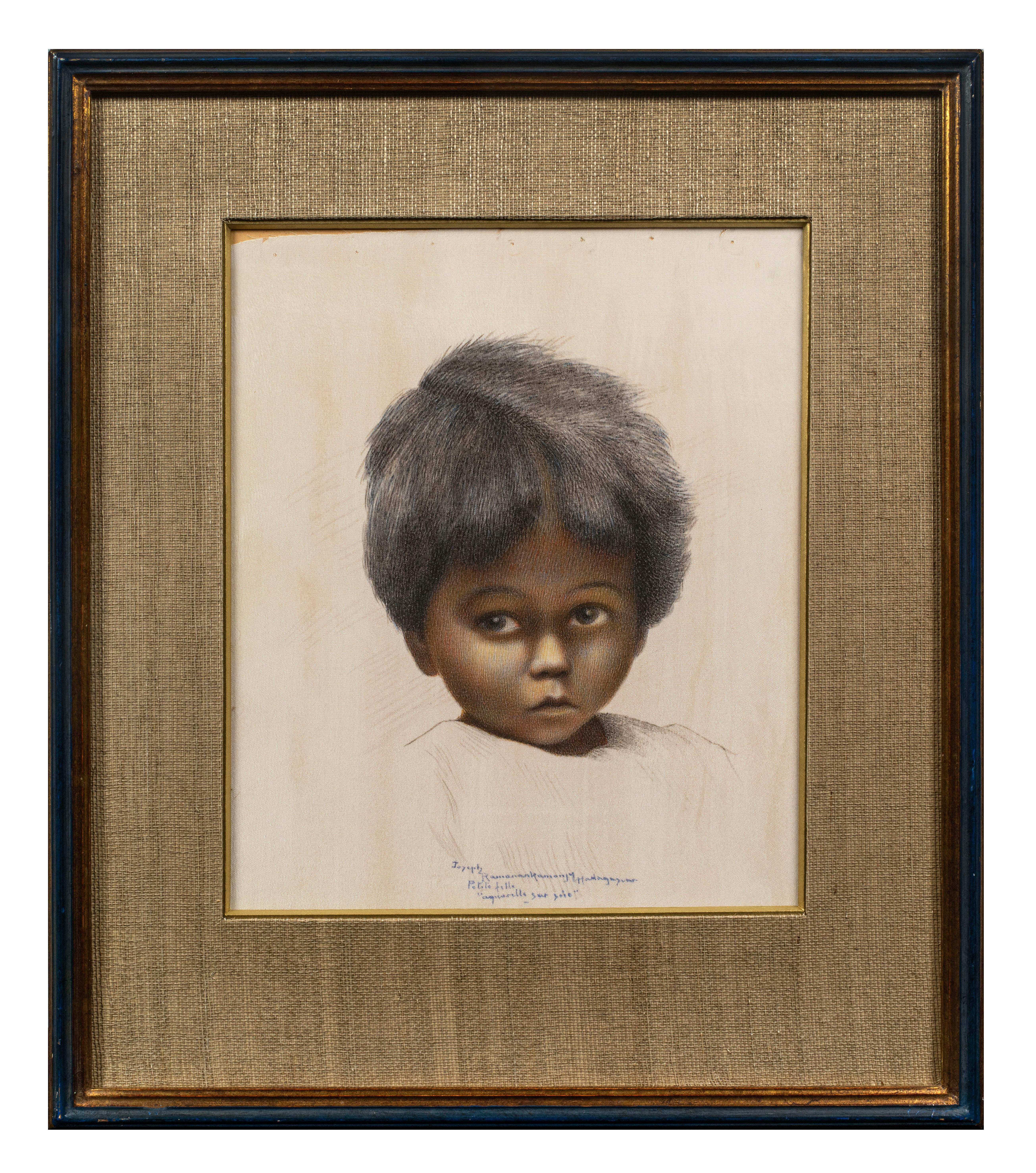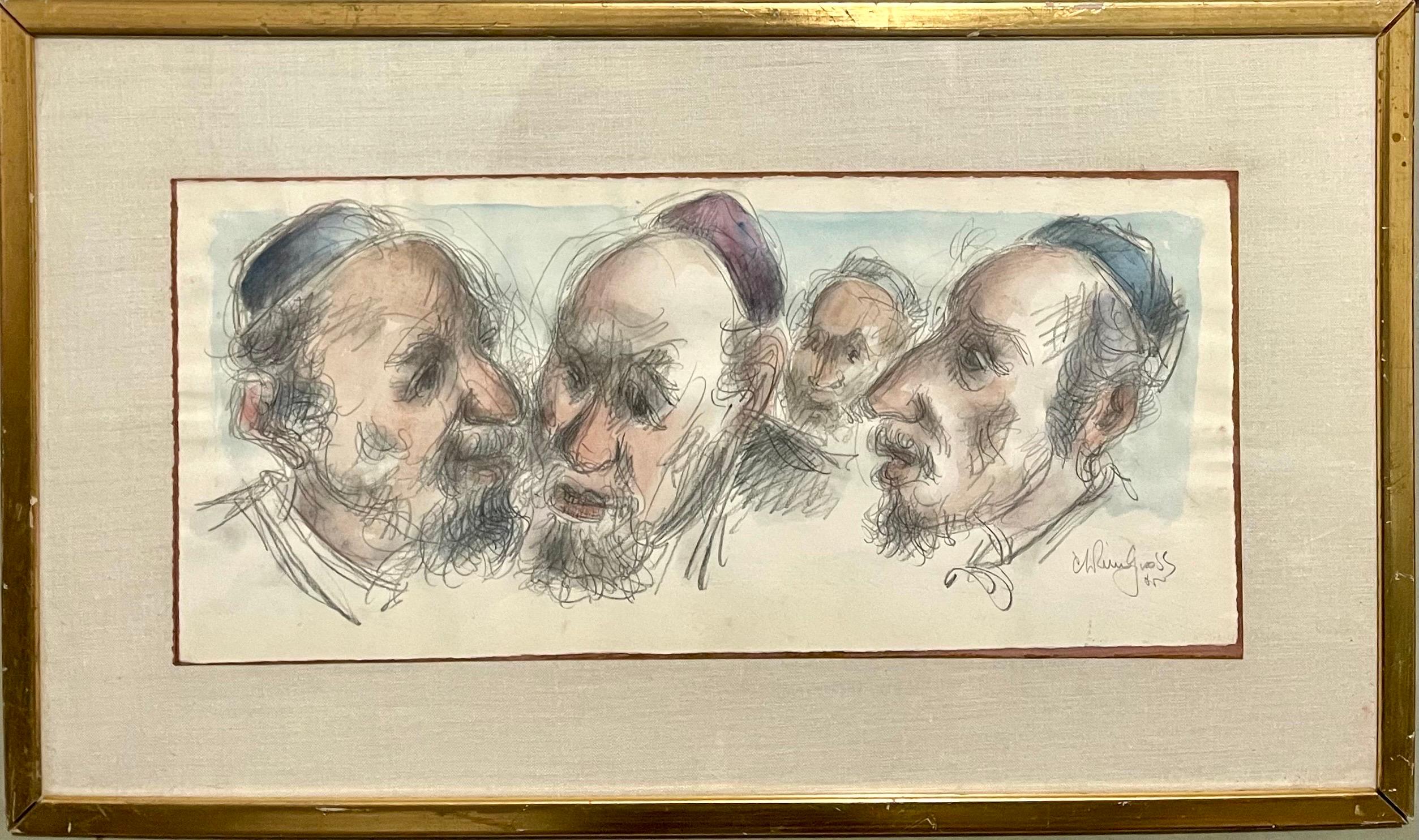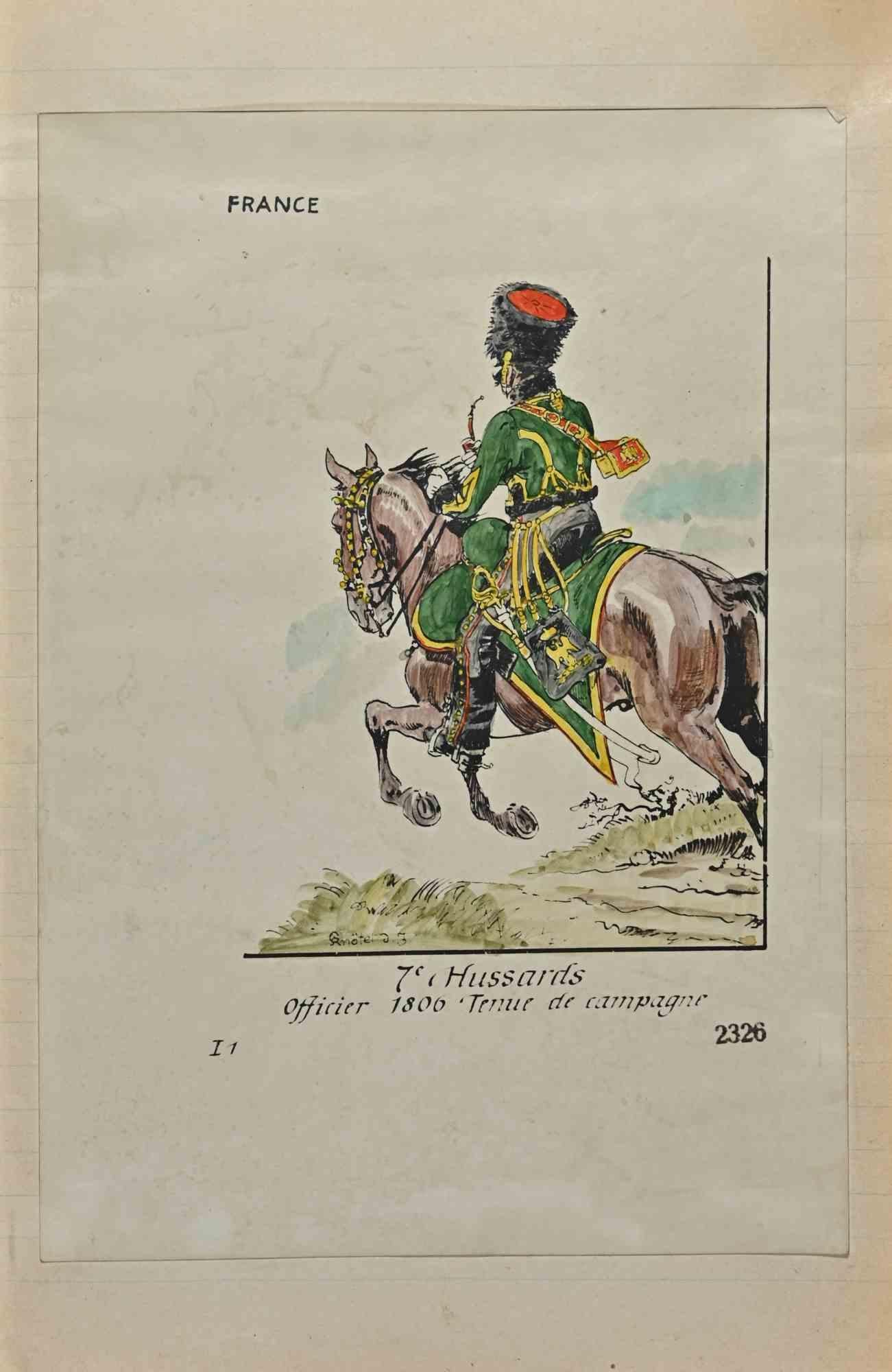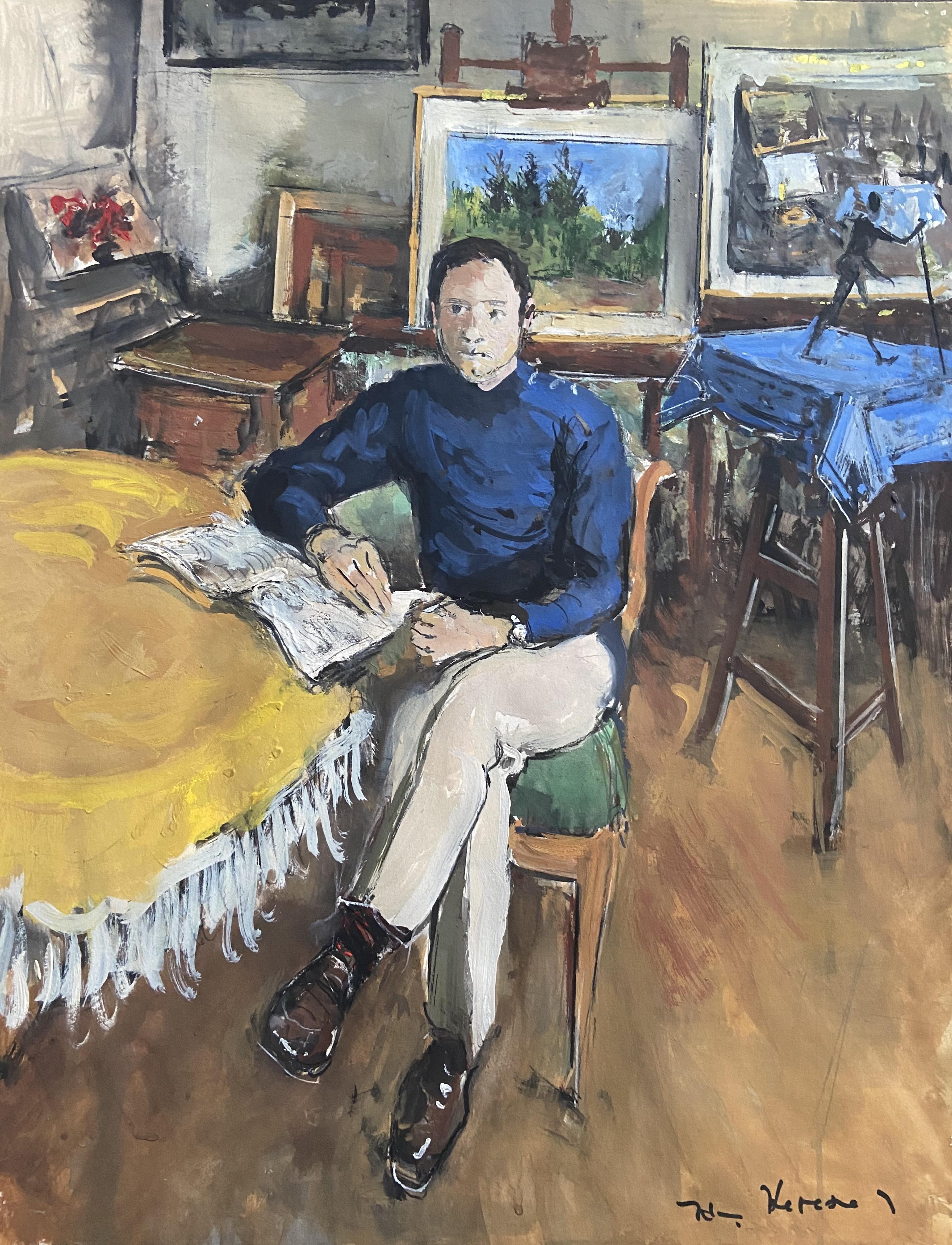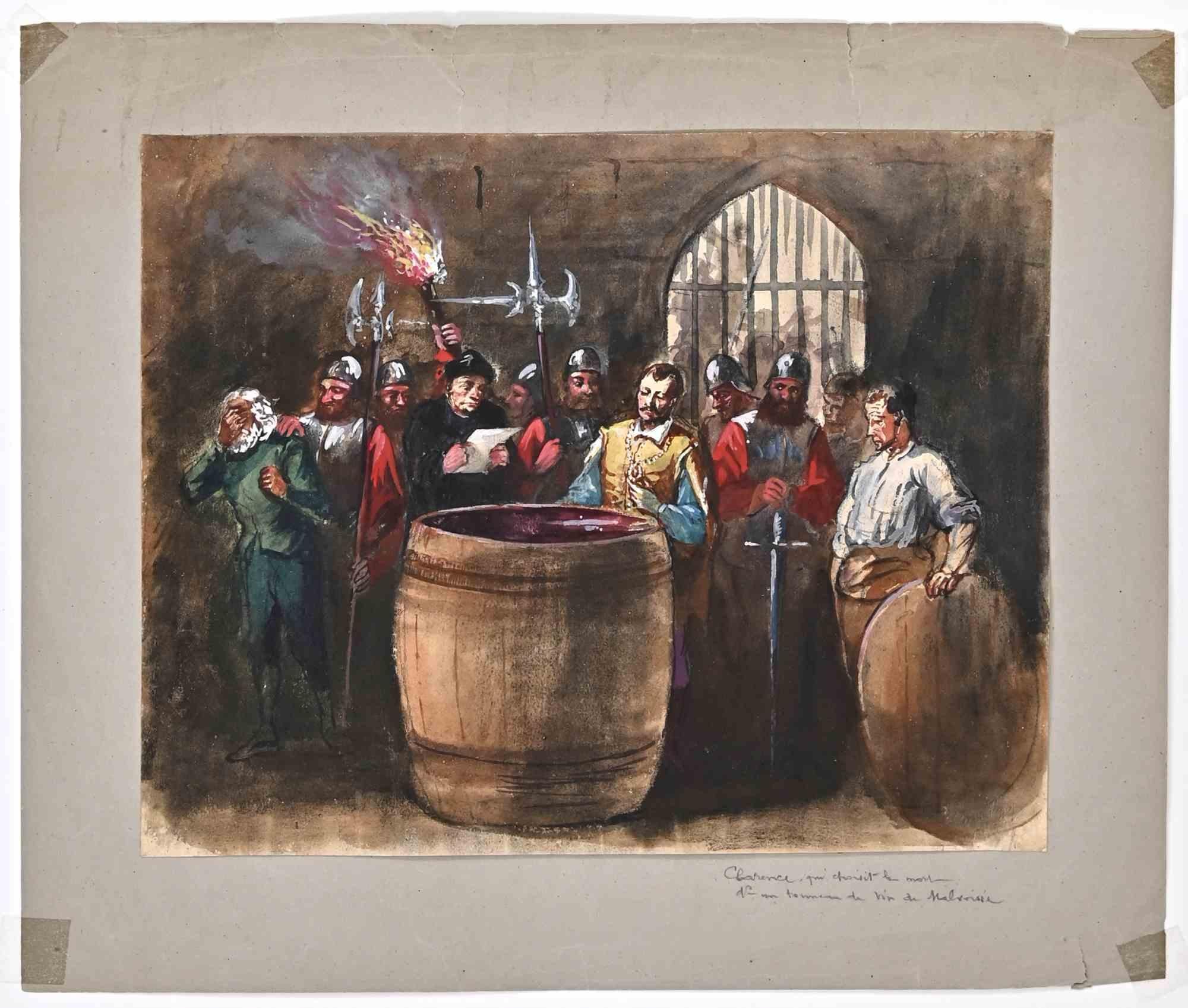Items Similar to Un Enfant
Want more images or videos?
Request additional images or videos from the seller
1 of 3
Joseph RamanankamonjyUn Enfant
About the Item
Signed and inscribed, lower center: Joseph / Ramanankamonjy / un enfant / Madagascar / “sanguine sur soie”
Provenance:
Private Collection, Paris
Private Collection, Florida
Sometimes one comes across an artist almost completely divorced from the mainstream of critical attention, but whose work reveals a quality and interest that demands appreciation. Such a figure is Joseph Ramanankamonjy, a painter locally revered in his native Madagascar, but virtually unknown outside of it.
The subjects of Ramanankamonjy’s works were exclusively drawn from his homeland—landscapes, dwellings, scenes of everyday life, and portrait drawings, of which the present works are particularly fine examples. But while he was educated in Madagascar—training with local artists, then attending the School of Fine Arts at Andafiavaratra Palace in the capital city of Antananarivo (Tananarive)—he exhibited frequently in France, first showing his work in Paris in 1928 and later in 1948, 1949, and 1959. In 1931 he was part of the Malagasy Delegation to the Exposition Coloniale Internationale held in the Bois de Vincennes in Paris. This massive exhibition, controversial in its day, attempted to extoll the beneficent aspects of colonialism, particularly among French possessions, of which Madagascar was one from 1897 until its independence in 1960.
By the time of the Colonial Exhibition, Ramanankamonjy had developed his signature mode of portraiture, painting intense images on small pieces of silk. One of these, now in the Musée du Quai Branly in Paris, is dated 1930 (Fig. 1). It depicts a young Malagasy woman—her face, hair, and pendant earrings meticulously delineated—while the balance of her body is only summarily indicated. She is designated as a Hova, the free commoner caste of the Merina people, the largest ethnic group in Madagascar.
Our works are undated but clearly somewhat later in date given their more sophisticated modelling and focus on the subject. In Petite Fille Ramanankamonjy has introduced a more varied palette, rendering the tonalities of the girl’s face in a succession of fine brushstrokes ranging from yellows to browns to blues, while giving great attention to her hair, articulated with variations in grays. A detail photograph gives some indication of the remarkable technique employed by the artist (Fig. 2).
Un Enfant, executed in sanguine, dwells on the soft forms of the child’s face, revealed by lambent light from above. The young girl’s hair is depicted with equal care, with special emphasis given to the braids—proud hallmarks of Malagasy culture. There is a directness and honesty in the artist’s portraits—most of which are of children—which, while veering towards the sentimental, maintain the integrity and dignity of the sitters. A review of the artist’s 1949 exhibition at L’Agence des Colonies in Paris stressed the humanity and sympathy with which Ramanankamonjy approached his subjects, the finesse of his technique, and the uniqueness of his watercolor-on-silk medium (Fig. 3).
Besides exhibitions in France, Ramanankamonjy showed his work on the Indian Ocean islands of Mauritius and Réunion. Otherwise he worked and exhibited exclusively in Madagascar (Fig. 4). He received numerous honors and awards in his homeland, becoming the first artist member of the Malagasy Academy, leading to his induction into the French Legion d’honneur, first as a Chevalier in 1950, then as Officier in 1960. He was the subject of retrospective exhibitions in Antanarivo, most recently in 2014, the thirtieth anniversary of his death. Nonetheless, other than locally, he remains largely an unknown figure.
- Creator:
- Dimensions:Height: 10 in (25.4 cm)Width: 8 in (20.32 cm)
- Medium:
- Movement & Style:
- Period:
- Condition:
- Gallery Location:New York, NY
- Reference Number:1stDibs: LU1027006522

About the Seller
5.0
Recognized Seller
These prestigious sellers are industry leaders and represent the highest echelon for item quality and design.
Established in 1997
1stDibs seller since 2012
17 sales on 1stDibs
Typical response time: 11 hours
- ShippingRetrieving quote...Ships From: New York, NY
- Return PolicyThis item cannot be returned.
More From This SellerView All
- Petite FilleBy Joseph RamanankamonjyLocated in New York, NYSigned and inscribed, lower center: Joseph / Ramanankamonjy / Madagascar / Petite fille / “aquarelle sur soie” Provenance: Private Collection, Paris Private Collection, Florida Som...Category
20th Century Modern Figurative Drawings and Watercolors
MaterialsSilk, Watercolor
- The ArgumentLocated in New York, NYSigned and inscribed on a label on the verso: No. 1/ The Argument/ W. Cave Thomas/ 203 Camden Rd/ NW Provenance: Christie’s, London, 6 November 1995, lot 88. Private Collection, London. This powerful watercolor is a mature work by the little-known Victorian painter William Cave Thomas...Category
19th Century Pre-Raphaelite Portrait Drawings and Watercolors
MaterialsPaper, Watercolor, Pencil
- Head of a Cheerful Man Wearing a CapLocated in New York, NYWatermark: the arms of Amsterdam Provenance: Christie’s, Amsterdam, 1 December 1986, lot 46; where acquired by: Private Collection, New York Literature: Roger Adolf d’Hulst, “Jordaens Drawings: Supplement II,” Master Drawings, vol. 28, no. 2 (1990), pp. 153-156, no. A237a, fig. 17. Matías Díaz Padrón, Jacob Jordaens...Category
17th Century Baroque Portrait Drawings and Watercolors
MaterialsPaper, Chalk
- Portrait of a GentlemanLocated in New York, NYPen, black ink, wash, and white heightening on blue paper Provenance: with F. R. Meatyard, London, around 1925; where acquired by: Dan Fellows Platt, Englewood, New Jersey; by descent to his wife: Ethel Bliss Platt; by whom given to: The Princeton University Art Museum; by whom consigned to: Schaeffer Galleries, New York, 1944; where acquired by: Wilhelm Suida; thence by descent to: Robert L. and Bertina Suida Manning, New York, 1959-1996 Private Collection, USA Literature: Janos Scholz, “Italian Drawings in The Art Museum, Princeton University,” The Burlington Magazine, vol. 109, no. 770 (May 1967), pp. 296, 299. Elaine Claye, “A Group of Portrait Drawings by Jacopo Amigoni...Category
18th Century Old Masters Portrait Drawings and Watercolors
MaterialsPaper, Ink, Pen
- Study of JobBy Lesser UryLocated in New York, NYSigned, dated, and titled, lower left: L Ury/ 1883/ Studie zum Hiob Provenance: Mr. and Mrs. Dennis Berger, New York, until 2005; thence by descent. Literature: Illustrated in...Category
Late 19th Century Impressionist Nude Drawings and Watercolors
MaterialsCharcoal, Board
- Woman in Fantasy Costume (pair)By Jean Baptist Le PrinceLocated in New York, NYThe pair consists of the present work and an engraving after it by the hand of Giles DeMarteau (Liège 1722 – 1776 Paris) titled Woman in Fantasy Costume, after Jean Baptiste Le Prince, and measuring, 10 ⅜ x 8 ⅝ inches (26.5 x 22 cm). DeMarteau's engraving is inscribed at the bottom: Le Prince inv. del. / Demarteau sc. / A Paris ches Demarteau Graveur du Roi, rue de la Pelterie à la Cloche...Category
18th Century Drawings and Watercolor Paintings
MaterialsPaper, Chalk, Engraving
You May Also Like
- Chaim Gross Mid Century Mod Judaica Jewish Watercolor Painting Rabbis WPA ArtistBy Chaim GrossLocated in Surfside, FLChaim Gross (American, 1904-1991) Watercolor painting Rabbinical Talmudic Discussion Hand signed 17 x 29 framed, paper 10 x 22 Chaim Gross (March 17, 1904 – May 5, 1991) was an American modernist sculptor and educator. Gross was born to a Jewish family in Austrian Galicia, in the village of Wolowa (now known as Mezhgorye, Ukraine), in the Carpathian Mountains. In 1911, his family moved to Kolomyia (which was annexed into the Ukrainian USSR in 1939 and became part of newly independent Ukraine in 1991). When World War I ended, Gross and brother Avrom-Leib went to Budapest to join their older siblings Sarah and Pinkas. Gross applied to and was accepted by the art academy in Budapest and studied under the painter Béla Uitz, though within a year a new regime under Miklos Horthy took over and attempted to expel all Jews and foreigners from the country. After being deported from Hungary, Gross began art studies at the Kunstgewerbeschule in Vienna, Austria shortly before immigrating to the United States in 1921. Gross's studies continued in the United States at the Beaux-Arts Institute of Design, where he studied with Elie Nadelman and others, and at the Art Students League of New York, with Robert Laurent. He also attended the Educational Alliance Art School, studying under Abbo Ostrowsky, at the same time as Moses Soyer and Peter Blume. In 1926 Gross began teaching at The Educational Alliance, and continued teaching there for the next 50 years. Louise Nevelson was among his students at the Alliance (in 1934), during the time she was transitioning from painting to sculpture. In the late 1920s and early 1930s he exhibited at the Salons of America exhibitions at the Anderson Galleries and, beginning in 1928, at the Whitney Studio Club. In 1929, Gross experimented with printmaking, and created an important group of 15 linocuts and lithographs of landscapes, New York City streets and parks, women in interiors, the circus, and vaudeville. The entire suite is now in the collection of the Philadelphia Museum of Art. Gross returned to the medium of printmaking in the 1960s, and produced approximately 200 works in the medium over the next two decades. For more than sixty years Chaim Gross's art has expressed optimistic, affirming themes, Judaica, balancing acrobats, cyclists, trapeze artists and mothers and children convey joyfulness, modernism, exuberance, love, and intimacy. This aspect of his work remained consistent with his Jewish Hasidic heritage, which teaches that only in his childlike happiness is man nearest to God. In March 1932 Gross had his first solo exhibition at Gallery 144 in New York City. For a short time they represented Gross, as well as his friends Milton Avery, Moses Soyer, Ahron Ben-Shmuel and others. Gross was primarily a practitioner of the direct carving method, with the majority of his work being carved from wood. Other direct carvers in early 20th-century American art include William Zorach, Jose de Creeft, and Robert Laurent. Works by Chaim Gross can be found in major museums and private collections throughout the United States, with substantial holdings (27 sculptures) at the Hirshhorn Museum and Sculpture Garden. A key work from this era, now at the Smithsonian American Art Museum, is the 1932 birds-eye maple Acrobatic Performers, which is also only one and one quarter inch thick. In 1933 Gross joined the government's PWAP (Public Works of Art Project), which transitioned into the WPA (Works Progress Administration), which Gross worked for later in the 1930s. Under these programs Gross taught and demonstrated art, made sculptures that were placed in schools and public colleges, made work for Federal buildings including the Federal Trade Commission Building, and for the France Overseas and Finnish Buildings at the 1939 New York World's Fair. Gross was also recognized during these years with a silver medal at the Exposition universelle de 1937 in Paris, and in 1942, with a purchase prize at the Metropolitan Museum of Art's "Artists for Victory" exhibition for his wood sculpture of famed circus performer Lillian Leitzel. In 1949 Gross sketched Chaim Weizmann, Israeli President, at several functions in New York City where Weizmann was speaking, Gross completed the bust in bronze later that year. Gross returned to Israel for three months in 1951 (the second of many trips there in the postwar years) to paint a series of 40 watercolors of life in various cities. This series was exhibited at the Jewish Museum (Manhattan) in 1953. He also did some important Hebrew medals. In the 1950s Gross began to make more bronze sculptures alongside his wood and stone pieces, and in 1957 and 1959 he traveled to Rome to work with famed bronze foundries including the Nicci foundry. At the end of the decade Gross was working primarily in bronze which allowed him to create open forms, large-scale works and of course, multiple casts. Gross's large-scale bronze The Family, donated to New York City in 1991 in honor of Mayor Ed Koch, and installed at the Bleecker Street Park at 11th street, is now a fixture of Greenwich Village. In 1959, a survey of Gross's sculpture in wood, stone, and bronze was featured in the exhibit Four American Expressionists curated by Lloyd Goodrich at the Whitney Museum of American Art, with work by Abraham Rattner, Doris Caesar, and Karl Knaths. In 1976, a selection from Gross's important collection of historic African sculpture, formed since the late 1930s, was exhibited at the Worcester Art Museum in the show The Sculptor's Eye: The African Art Collection of Mr. and Mrs. Chaim Gross. Gross was elected into the National Academy of Design as an Associate member, and became a full Academician in 1981. In 1984, he was inducted into the American Academy of Arts and Letters, with Jacob Lawrence and Lukas Foss. In the fall of 1991, Allen Ginsberg gave an important tribute to Gross at the American Academy of Arts and Letters, which is published in their Proceedings. In 1994, Forum Gallery, which now represents the Chaim Gross estate, held a memorial exhibition featuring a sixty-year survey of Gross's work.In March 1932 Gross had his first solo exhibition at Gallery 144 in New York City. For a short time they represented Gross, as well as his friends Milton Avery, Moses Soyer, Ahron Ben-Shmuel and others. Gross was primarily a practitioner of the direct carving method, with the majority of his work being carved from wood. Other direct carvers in early 20th-century American art include William Zorach, Jose de Creeft, and Robert Laurent. Works by Chaim Gross can be found in major museums and private collections throughout the United States, with substantial holdings (27 sculptures) at the Hirshhorn Museum and Sculpture Garden. A key work from this era, now at the Smithsonian American Art Museum, is the 1932 birds-eye maple Acrobatic Performers, which is also only one and one quarter inch thick. In 1933 Gross joined the government's PWAP (Public Works of Art Project), which transitioned into the WPA (Works Progress Administration), which Gross worked for later in the 1930s. Under these programs Gross taught and demonstrated art, made sculptures that were placed in schools and public colleges, made work for Federal buildings including the Federal Trade Commission Building, and for the France Overseas and Finnish Buildings at the 1939 New York World's Fair. Gross was also recognized during these years with a silver medal at the Exposition universelle de 1937 in Paris, and in 1942, with a purchase prize at the Metropolitan Museum of Art's "Artists for Victory" exhibition for his wood sculpture of famed circus performer Lillian Leitzel. In 1949 Gross sketched Chaim Weizmann, President of Israel, at several functions in New York City where Weizmann was speaking, Gross completed the bust in bronze later that year. Gross returned to Israel for three months in 1951 (the second of many trips there in the postwar years) to paint a series of 40 watercolors of life in various cities. This series was exhibited at the Jewish Museum (Manhattan) in 1953. In the 1950s Gross began to make more bronze sculptures alongside his wood and stone pieces, and in 1957 and 1959 he traveled to Rome to work with famed bronze foundries including the Nicci foundry. At the end of the decade Gross was working primarily in bronze which allowed him to create open forms, large-scale works and of course, multiple casts. Gross's large-scale bronze The Family, donated to New York City in 1991 in honor of Mayor Ed Koch, and installed at the Bleecker Street Park at 11th street, is now a fixture of Greenwich Village. In 1959, a survey of Gross's sculpture in wood, stone, and bronze was featured in the exhibit Four American Expressionists curated by Lloyd Goodrich at the Whitney Museum of American Art, with work by Abraham Rattner, Doris Caesar, and Karl Knaths. In 1976, a selection from Gross's important collection of historic African sculpture, formed since the late 1930s, was exhibited at the Worcester Art Museum in the show The Sculptor's Eye: The African Art Collection of Mr. and Mrs. Chaim Gross. Gross was elected into the National Academy of Design as an Associate member, and became a full Academician in 1981. In 1984, he was inducted into the American Academy of Arts and Letters, with Jacob Lawrence and Lukas Foss. In the fall of 1991, Allen Ginsberg gave an important tribute to Gross at the American Academy of Arts and Letters, which is published in their Proceedings. In 1994, Forum Gallery, which now represents the Chaim Gross estate, held a memorial exhibition featuring a sixty-year survey of Gross's work. Gross was a professor of printmaking and sculpture at both the Educational Alliance and the New School for Social Research in New York City, as well as at the Brooklyn Museum Art School, the MoMA art school, the Art Student's League and the New Art School (which Gross ran briefly with Alexander Dobkin...Category
Mid-20th Century American Modern Figurative Drawings and Watercolors
MaterialsPaper, Watercolor
- 7e Hussards - Drawing By Herbert Knotel - 1940sLocated in Roma, IT7e Hussards is an original drawing in ink and watercolor realized by Herbert Knotel in 1930/40s. Good condition except for being aged. Hand-signed. T...Category
1940s Modern Figurative Drawings and Watercolors
MaterialsWatercolor, Ink
- 7e Hussards - Drawing By Herbert Knotel - 1940sLocated in Roma, IT7e Hussards is an original drawing in ink and watercolor realized by Herbert Knotel in 1930/40s. Good condition except for being aged. Hand-signed. T...Category
1940s Modern Figurative Drawings and Watercolors
MaterialsWatercolor, Ink
- Jacques Thevenet (1891-1989) Portrait of a man in the studio, signed GouacheBy Jacques ThévenetLocated in Paris, FRJacques Thevenet (1891-1989) Portrait of a man in the studio Gouache on paper Signed lower right 64 x 49 cm Framed 77 x 62 cm, some damages to the frame as visible on the photographs Jacques Thévenet was born in Montquinon 17 October 1891, in the family’s ancestral home, built by his great grand-father, Auguste Hugues Claude Thévenet, lawyer from Château-Chinon. He had 3 sisters and lost his mother in 1895 when he was only four. His father Louis moved the family to Paris where he run a law practice. Young Jacques studied at the Lycée Carnot and later attended the École de droit of the Sorbonne University. Simultaneously, he attended the Académie Julian, with several painters such as Amédée de la Patellière, Jean Crotti...Category
1960s Modern Portrait Drawings and Watercolors
MaterialsGouache
- Richard III - Drawing by Charles Amelot - Early 19th CenturyLocated in Roma, ITRichard III is an original ink and watercolor drawing realized by Charles Amelot (1759-1830). Good condition, included a white cardboard passpartout (37.5x55 cm). The artwork repre...Category
Early 19th Century Modern Portrait Drawings and Watercolors
MaterialsInk, Watercolor, Paper
- Pierre Olivier Dubaut (1886-1968) Portrait of an artist, watercolorLocated in Paris, FRPierre Olivier Dubaut (1886-1968) Portrait of an artist Stamp of the artist on the lower part watercolor on paper 46.5 x 30 cm In a vintage frame : 58 x 42 cm, some damages in the ...Category
1930s Modern Portrait Drawings and Watercolors
MaterialsWatercolor
Recently Viewed
View AllMore Ways To Browse
French Pendant Petite
Indian Colonial Art
Braided Woman
Portrait Indian Woman
Independence Day
Indian Vintage Earrings
Indian Girl
Pendants Figs
Framed Sanguine
Indian Child Portrait
Children Earrings
Childrens Earrings
Young Girl 1930 Portrait
Girl With Braids
Vintage Hair Braid
Indian Pendant Light
Reunion Island
Vintage Indian Girl
